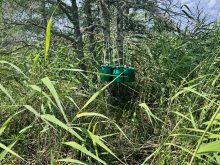HALIFAX – Farm leaders listened for the better part of an hour recently as agri-food representatives described their vision of a food sector in which all the players co-operate as partners.
It was a session about forging links along the value chain held during the Canadian Federation of Agriculture’s semi-annual meeting in Halifax, and a main message was that governments and their pernicious regulations are a large part of the problem.
It is up to the business side of the industry to create a model and strategy that makes the sector more efficient, world competitive and not burdened by unnecessary costs, they said.
Read Also

Research looks to control flea beetles with RNAi
A Vancouver agri-tech company wants to give canola growers another weapon in the never-ending battle against flea beetles.
Farm representatives, already immersed in an effort to create a national food strategy that would require acceptance from all sectors, listened and then weighed in with a question that was on many of their minds: where does farmer profitability fit into this value chain vision?
They received no clear answers.
Keystone Agricultural Producers president Ian Wishart said KAP has tracked the farmer share of the food dollar for several years.
“The farmer is getting increasingly less of the consumer food dollar,” he said.
The more processed the product, the less the farmer share, he added.
Wishart said the trend in Europe is the opposite as farmers capture more of the food dollar.
“Why do we have a problem and what can we do to solve it?”
National Millers’ Association president Gord Harrison stuck to his main argument that inappropriate regulations add costs to the system and that costs would be pushed out of the system and more money would be available for everyone if all players co-operated to advocate for regulatory change.
He said he has long heard farmer arguments about grain farmers’ tiny share of the profits from a loaf of bread.
“I won’t comment on its relevance.”
Other farm leaders asked the same question in different ways.
Canadian Pork Council president Jurgen Preugschas said the food industry is largely a low margin business but under the present model, farmers assume most of the risk and receive little of the profit.
“How can we get some of that risk shared up the line and the profits shared down the line?” he said.
Maple Leaf Foods vice-president Rory McAlpine insisted risk does flow up the chain to the processors, and profits in the food and beverage industries have also declined.
“We’ve got a shared problem,” he said. “Hopefully there is unity in crisis.”
He said part of the answer is working together to convince consumers that they do not put a high enough value on food.
Harrison made the same point about risk and profits, saying the milling industry is also a low margin business.
“And it is understandable that you see that you bear all the risk,” he said. “I can assure you that is not the case.”
In later interviews, CFA members said they were unsatisfied by the responses and the lack of recognition that farmers receive little of the profits generated in a profitable food industry.
“I’m disappointed and frustrated,” Wishart said. “I just don’t hear anything from them about farm profitability, but a sustainable industry requires that all levels are profitable.”
He said his Manitoba farm has joined partnership arrangements with processors.
“But I’m no longer a partner,” he said. “I’m now referred to as a supplier.”
CFA president Ron Bonnett said the core issue is the need for a new industry model that gives farmers more market power.
“I think what we will see evolve is those linkages will become much stronger and a better business model will be needed,” he said.
“As farmers, we have to take a look at how we organize ourselves to deal with the companies with more market power.”
He said it may be time to revisit the scene a century ago when farmers found ways to join together to counteract their market weakness in the face of more powerful corporate interests.
















